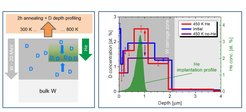Hydrogen isotope accumulation in the helium implantation zone in tungsten
In tungsten hydrogen is trapped in defects of the crystal lattice, which can be created by ion bombardment. The question whether the implantation of helium ions leads to a reduction or an increase of the hydrogen retention in tungsten was controversially discussed. A sophisticated experiment sheds new light on this problem
Recent experiments investigating the plasma-surface interaction of He-seeded deuterium (D) plasmas with tungsten (W) have resulted in a reduced D retention compared with pure D plasmas. A possible explanation for the reduced retention is that implanted He might create a diffusion barrier for D transport, thus reducing D uptake in the W bulk during plasma exposure. To test this hypothesis, the influence of He on D transport and retention in W was studied in a joint experiment of Jožef Stefan Institute (JSI, Ljubljana, Slovenia) and IPP.
Helium was implanted 1 μm deep into polycrystalline W to a maximum calculated concentration of 3.4 at.%. To minimize the influence of displacement damage created during He implantation on D retention, so-called self-damaged W was used. W was damaged by 20 MeV W ion bombardment and defects were populated by low-temperature D plasma at room temperature before He implantation. Deuterium depth profiling was performed in situ during isochronal annealing in the temperature range from 300 to 800 K.

For the first time, this work unambiguously shows that He does not act as a diffusion barrier, but attracts D and locally increases D trapping. After sample annealing at 450 K D retention in the He-enriched zone increased by a factor of two as compared to the non-He-implanted W reference. Rate equation modelling can explain the measured D depth profiles quantitatively when keeping the de-trapping parameters unchanged but only increasing the number of traps in the He zone. These results bolster confidence in theoretical calculations predicting that more hydrogen isotopes can be stored around a He-cluster zone.
This work was recently published in Nuclear Fusion:
Markelj et al., Nucl. Fusion 57 (2017) 064002 (5pp)
Link: https://doi.org/10.1088/1741-4326/aa6b27
